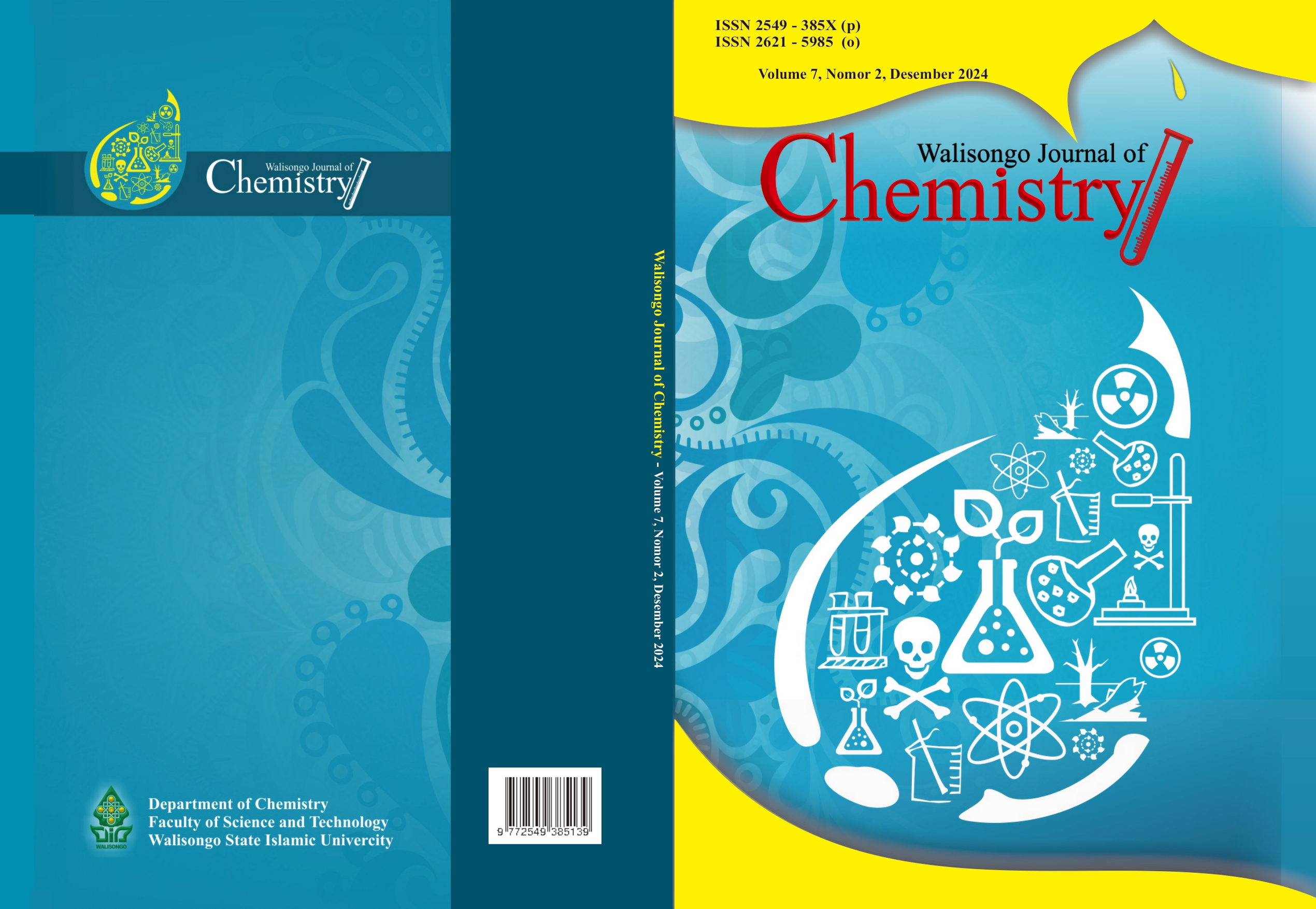A Novel Synthesis Pathway for Silver Nanoparticles Using Anthurium Bipinnatifidum
DOI:
https://doi.org/10.21580/wjc.v7i2.23862Keywords:
Anthurium bipinnatifidum, silver nanoparticle, green synthesis, AgNPs, SPRAbstract
The field of nanomaterial synthesis has grown substantially in recent years. However, many existing synthesis methods have significant drawbacks, such as the use of organic solvents that are harmful to the environment and the high cost of inorganic reducing agents. To address these issues, we developed a simple and cost-effective method for synthesizing silver nanoparticles (AgNPs) using Anthurium bipinnatifidum extract as a reducing agent and water as a green solvent. This green chemistry approach offers a quick and straightforward synthesis process, with the optimum incubation time and volume were 1 hour and 0.5 mL, respectively. The results of this new method show promising characteristics, as demonstrated by SEM, UV-Vis spectrophotometry, and FTIR analyses. Additionally, the surface plasmon resonance (SPR) of the synthesized AgNPs was observed at 431 nm, which aligns with the typical SPR for AgNPs. The particles formed were spherical, with sizes ranging from approximately 40 to 80 nm. This research establishes an efficient new procedure for AgNPs synthesis with excellent outcomes.
Downloads
References
Abid, N., Khan, A. M., Shujait, S., Chaudhary, K., Ikram, M., Imran, M., Haider, J., Khan, M., Khan, Q., & Maqbool, M. (2022). Synthesis of nanomaterials using various top-down and bottom-up approaches, influencing factors, advantages, and disadvantages: A review. Advances in Colloid and Interface Science, 300, 102597. https://doi.org/https://doi.org/10.1016/j.cis.2021.102597
Burlec, A. F., Corciova, A., Boev, M., Batir-Marin, D., Mircea, C., Cioanca, O., Danila, G., Danila, M., Bucur, A. F., & Hancianu, M. (2023). Current overview of metal nanoparticles’ synthesis, characterization, and biomedical applications, with a focus on silver and gold nanoparticles. Pharmaceuticals, 16(10), 1410.
Coates, J. (2006). Interpretation of Infrared Spectra, A Practical Approach. In. https://doi.org/10.1002/9780470027318.a5606
D Meer, S., Naidoo, Y., H Dewir, Y., Lin, J., & Z Rihan, H. (2022). Green synthesis of silver nanoparticles from Heteropyxis natalensis leaf extract and their potential antibacterial efficacy.
da Silva, J. A. T., Dobránszki, J., Winarto, B., & Zeng, S. (2015). Anthurium in vitro: a review. Scientia Horticulturae, 186, 266-298.
Dawadi, S., Katuwal, S., Gupta, A., Lamichhane, U., Thapa, R., Jaisi, S., Lamichhane, G., Bhattarai, D. P., & Parajuli, N. (2021). Current research on silver nanoparticles: synthesis, characterization, and applications. Journal of nanomaterials, 2021(1), 6687290.
Escudero, A., Carrillo-Carrión, C., Romero-Ben, E., Franco, A., Rosales-Barrios, C., Castillejos, M. C., & Khiar, N. (2021). Molecular bottom-up approaches for the synthesis of inorganic and hybrid nanostructures. Inorganics, 9(7), 58.
Fahmi, A. G., Widyaningtyas, N., Martoprawiro, M. A., & Saputra, I. S. (2024). Synthesis and characterization of silver nanoparticles (AgNPs) from liquid waste of laboratory experiment. AIP Conference Proceedings,
Ganguly, A., Trovato, O., Duraisamy, S., Benson, J., Han, Y., Satriano, C., & Papakonstantinou, P. (2019). Organic solvent based synthesis of gold nanoparticle− semiconducting 2H-MoS2 hybrid nanosheets. The Journal of Physical Chemistry C, 123(16), 10646-10657.
Gao, R., Chen, J., Fan, G., Jiao, W., Liu, W., Liang, C., Ren, H., Wang, Y., Ren, S., & Wei, Q. (2022). Optical properties of formation of gold nanoparticle aggregates deposited on quartz glass and application to SPR sensing. Optical Materials, 125, 112104.
Jain, S., & Mehata, M. S. (2017). Medicinal plant leaf extract and pure flavonoid mediated green synthesis of silver nanoparticles and their enhanced antibacterial property. Scientific reports, 7(1), 15867.
Mukherjee, P. (2021). Green chemistry–A novel approach towards sustainability. Journal of the Chilean Chemical Society, 66(1), 5075-5080.
Mutha, R. E., Tatiya, A. U., & Surana, S. J. (2021). Flavonoids as natural phenolic compounds and their role in therapeutics: An overview. Future journal of pharmaceutical sciences, 7, 1-13.
Putra, N. R., Yustisia, Y., Heryanto, R. B., Asmaliyah, A., Miswarti, M., Rizkiyah, D. N., Yunus, M. A. C., Irianto, I., Qomariyah, L., & Rohman, G. A. N. (2023). Advancements and challenges in green extraction techniques for Indonesian natural products: A review. South African Journal of Chemical Engineering, 46(1), 88-98.
Ratri, M. C., Suh, J., Ryu, J., Chung, B. G., & Shin, K. (2023). Formulation of three‐dimensional, photo‐responsive printing ink: Gold nanorod‐hydrogel nanocomposites and their four‐dimensional structures that respond quickly to stimuli. Journal of Applied Polymer Science, 140(16), e53799.
Sariwati, A., Fitri, I., Purnomo, A. S., & Fatmawati, S. (2019). Phytochemical, antibacterial, and antioxidant activities of Anthurium Hookerii leaves extracts. HAYATI Journal of Biosciences, 26(3), 101-101.
Szczyglewska, P., Feliczak-Guzik, A., & Nowak, I. (2023). Nanotechnology–general aspects: A chemical reduction approach to the synthesis of nanoparticles. Molecules, 28(13), 4932.
Taba, P., Parmitha, N. Y., & Kasim, S. (2019). Sintesis nanopartikel perak menggunakan ekstrak daun salam (Syzygium polyanthum) sebagai bioreduktor dan uji aktivitasnya sebagai antioksidan. Indonesian Journal of Chemical Research, 7(1), 51-60.
Wijaya, H., Novitasari, N., & Jubaidah, S. (2018). Perbandingan metode ekstraksi terhadap rendemen ekstrak daun rambai laut (Sonneratia caseolaris L. Engl). Jurnal ilmiah manuntung, 4(1), 79-83.
Xiong, S., Cao, X., Fang, H., Guo, H., & Xing, B. (2021). Formation of silver nanoparticles in aquatic environments facilitated by algal extracellular polymeric substances: Importance of chloride ions and light. Science of the Total Environment, 775, 145867.
Yaqoob, A. A., Ahmad, H., Parveen, T., Ahmad, A., Oves, M., Ismail, I. M., Qari, H. A., Umar, K., & Mohamad Ibrahim, M. N. (2020). Recent advances in metal decorated nanomaterials and their various biological applications: a review. Frontiers in chemistry, 8, 341.
Downloads
Published
How to Cite
Issue
Section
License
Copyright (c) 2024 Walisongo Journal of Chemistry

This work is licensed under a Creative Commons Attribution-NonCommercial-ShareAlike 4.0 International License.
The copyright of the received article shall be assigned to the publisher of the journal. The intended copyright includes the right to publish the article in various forms (including reprints). The journal maintains the publishing rights to published articles.
In line with the license, authors and any users (readers and other researchers) are allowed to share and adapt the material. In addition, the material must be given appropriate credit, provided with a link to the license, and indicated if changes were made. If authors remix, transform or build upon the material, authors must distribute their contributions under the same license as the original.









